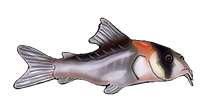Lophiobagrus Brevispinis
-
Sergio Moreira
- Posts: 5
- Joined: 23 Aug 2006, 10:20
- Location 1: Lisbon - Portugal
Lophiobagrus Brevispinis
Hello colleagues,
I'm writting from Portugal, and, at first, I would like to congrat you all for this superb forum.
I have been recently given the opportunity to acquire 2 F0 (wild)individuals of this very rare species.
I have partially used your forum to learn a bit more about this african catfish, as I knew nothing at all about it.
I am still unable do confirm the gender of each fish...
Now, one thing that is confusing me, maybe because I am still a rookie on the catfish world, is that both individuals are sharing the same cave. Does this mean it's a couple? Maybe 2 females? Or this is no proof at all of their gender, as 2 males can often share the same cave?
I will be anxiously standing-by to hear from you.
Should you require further information, please advise.
Many thanks and best regards.
Sérgio Moreira
PS- A few photos (credits to Nelson Oliveira). Hope you enjoy!
Please check the following link, as I was for some reason unable to collate the photos: http://www.aquariofiliadigital.com/viewtopic.php?t=3266
I'm writting from Portugal, and, at first, I would like to congrat you all for this superb forum.
I have been recently given the opportunity to acquire 2 F0 (wild)individuals of this very rare species.
I have partially used your forum to learn a bit more about this african catfish, as I knew nothing at all about it.
I am still unable do confirm the gender of each fish...
Now, one thing that is confusing me, maybe because I am still a rookie on the catfish world, is that both individuals are sharing the same cave. Does this mean it's a couple? Maybe 2 females? Or this is no proof at all of their gender, as 2 males can often share the same cave?
I will be anxiously standing-by to hear from you.
Should you require further information, please advise.
Many thanks and best regards.
Sérgio Moreira
PS- A few photos (credits to Nelson Oliveira). Hope you enjoy!
Please check the following link, as I was for some reason unable to collate the photos: http://www.aquariofiliadigital.com/viewtopic.php?t=3266
- sidguppy
- Posts: 3827
- Joined: 18 Jan 2004, 12:26
- My articles: 1
- My images: 28
- My aquaria list: 5 (i:0)
- Spotted: 9
- Location 1: Southern Netherlands near Belgium
- Location 2: Noord Brabant, Netherlands
- Interests: African catfishes and oddballs, Madagascar cichlids; stoner doom and heavy rock; old school choppers and riding them, fantasy novels, travelling and diving in the tropics and all things nature.
- Contact:
Hi
nice find; you might check out this:
Lophiobagrus brevispinis
wich is written by me.
If yours are hiding in a single cave chances are fairly big it's a pair unless it's the only available cave!
but to check it out isn't too hard; you need to put both fish together in a bucket or some sort of container with a white or light bottom. viewed from above the male has a much wider head, the female has a narrower mouth. with males the widest part of the body (not counting pectoral fins) are the gills; with females the widest part is the belly.
This is particular good to see if the fish are almost the same size.
Apart from that; (sub) adults should rest in a cave of their own. they're social fish (unlike Lophiobagrus cyclurus wich is fiercely agressive to unwanted speciesmembers), but not so social that they share caves (youngsters do! but after they reach 1,5"/3-4cm or so they should seek out individual caves.
nice find; you might check out this:
Lophiobagrus brevispinis
wich is written by me.
If yours are hiding in a single cave chances are fairly big it's a pair unless it's the only available cave!
but to check it out isn't too hard; you need to put both fish together in a bucket or some sort of container with a white or light bottom. viewed from above the male has a much wider head, the female has a narrower mouth. with males the widest part of the body (not counting pectoral fins) are the gills; with females the widest part is the belly.
This is particular good to see if the fish are almost the same size.
Apart from that; (sub) adults should rest in a cave of their own. they're social fish (unlike Lophiobagrus cyclurus wich is fiercely agressive to unwanted speciesmembers), but not so social that they share caves (youngsters do! but after they reach 1,5"/3-4cm or so they should seek out individual caves.
Valar Morghulis
-
Sergio Moreira
- Posts: 5
- Joined: 23 Aug 2006, 10:20
- Location 1: Lisbon - Portugal
-
Sergio Moreira
- Posts: 5
- Joined: 23 Aug 2006, 10:20
- Location 1: Lisbon - Portugal
- sidguppy
- Posts: 3827
- Joined: 18 Jan 2004, 12:26
- My articles: 1
- My images: 28
- My aquaria list: 5 (i:0)
- Spotted: 9
- Location 1: Southern Netherlands near Belgium
- Location 2: Noord Brabant, Netherlands
- Interests: African catfishes and oddballs, Madagascar cichlids; stoner doom and heavy rock; old school choppers and riding them, fantasy novels, travelling and diving in the tropics and all things nature.
- Contact:
grats with the fry!
good job.however, you'd best leave them with the parents the next time, because the male will guard them until they're miniatures of the parents (but black); in that stadium of life they're much easier to take care of.
now you must be sure that there's current in that net-fry-tank, otherwise they'll die and fungus.
a good method is to put the outlet of a small filter or sponge filter above the net-tank; the water will continuously travel through and make sure there's oxygen for the baby cats.
also: make sure no other fish "suck" the fry right through the mesh.....especially cichlids or Syno's are notorious for pulling off that trick.
don't feed them until they're colored dark and are visibly searching for food. the water must be kept clean. a few ramshornsnails added is a good idea, they'll clear up food leftovers.
good job.however, you'd best leave them with the parents the next time, because the male will guard them until they're miniatures of the parents (but black); in that stadium of life they're much easier to take care of.
now you must be sure that there's current in that net-fry-tank, otherwise they'll die and fungus.
a good method is to put the outlet of a small filter or sponge filter above the net-tank; the water will continuously travel through and make sure there's oxygen for the baby cats.
also: make sure no other fish "suck" the fry right through the mesh.....especially cichlids or Syno's are notorious for pulling off that trick.
don't feed them until they're colored dark and are visibly searching for food. the water must be kept clean. a few ramshornsnails added is a good idea, they'll clear up food leftovers.
Valar Morghulis
-
Sergio Moreira
- Posts: 5
- Joined: 23 Aug 2006, 10:20
- Location 1: Lisbon - Portugal
Hello sidguppy,
At first, I shall thank you for your peace of advise. It has been very usefull, and I think it has been the major reason for success so far. Check this out:
The fry:

The new high tech breeding unit (includes aeration, flow and filtration):

I'me keeping 10% water changes/day, and I'm still not feeding the fry. I'll keep you posted.
Many thanks and best regards.
Sérgio Moreira
At first, I shall thank you for your peace of advise. It has been very usefull, and I think it has been the major reason for success so far. Check this out:
The fry:

The new high tech breeding unit (includes aeration, flow and filtration):

I'me keeping 10% water changes/day, and I'm still not feeding the fry. I'll keep you posted.
Many thanks and best regards.
Sérgio Moreira
-
Sergio Moreira
- Posts: 5
- Joined: 23 Aug 2006, 10:20
- Location 1: Lisbon - Portugal










